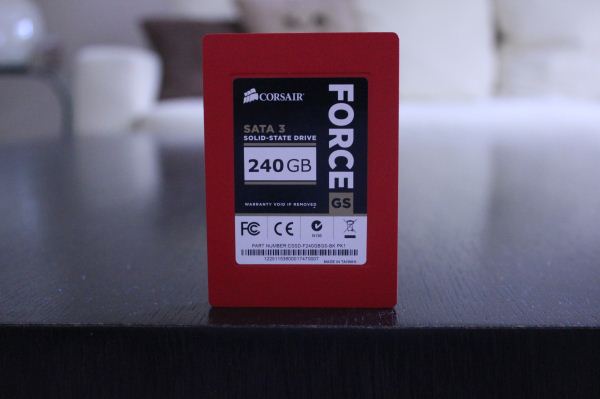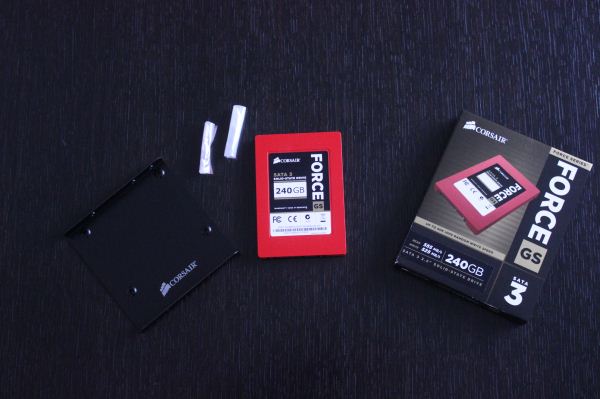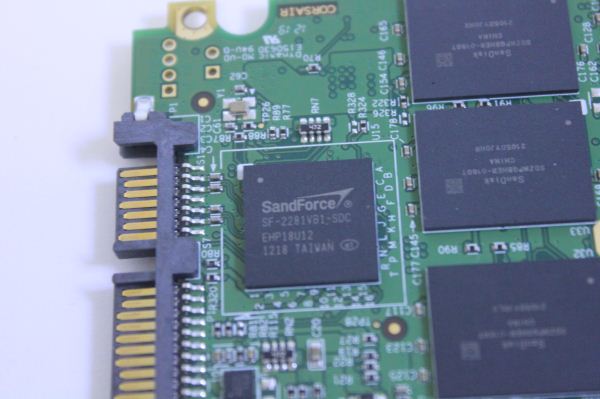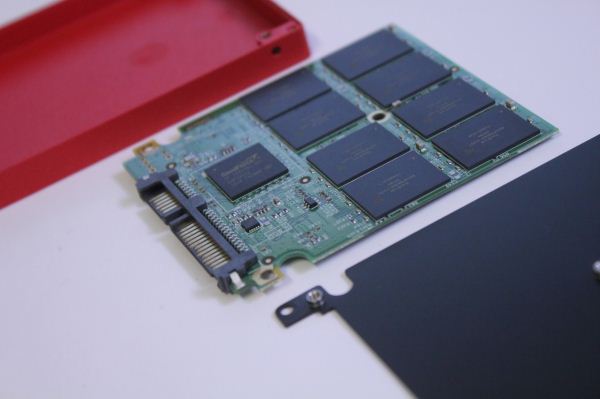SandForce TRIM Issue & Corsair Force Series GS (240GB) Review
by Kristian Vättö on November 22, 2012 1:00 PM ESTInside The Corsair Force GS
Corsair's Force GS uses a similar red plastic chassis as the Force GT.
Included in the retail bundle are two sets of mounting screws and a 2.5" to 3.5" adapter.
The actual PCB is a bit different from what we normally find inside 2.5" SSDs. Its length is only about four fifths of the backplane and it's held in tact by three screws (two in the corners, one in the middle) instead of four. I'm guessing the smaller PCB is slightly cheaper than a regular size 2.5" PCB would have been, hence Corsair opted for one. I don't really see any other explanation because the chassis is still normal size and weight benefit is marginal.
As for the components, there are eight SanDisk's 24nm Toggle-Mode MLC NAND packages on this side of the PCB. These are 16GB packages, meaning that each package consists of two 8GB dies.
Remove the backplane and flip the PCB around and we find another eight NAND packages and SandForce's SF-2281 controller.
Corsair isn't using thermal pads, which isn't all that suprising. Typically thermal pads are only found in high-end SSDs while lower-end models come without in order to offer more competitive pricing.
Test System
| CPU |
Intel Core i5-2500K running at 3.3GHz (Turbo and EIST enabled) |
| Motherboard |
AsRock Z68 Pro3 |
| Chipset |
Intel Z68 |
| Chipset Drivers |
Intel 9.1.1.1015 + Intel RST 10.2 |
| Memory | G.Skill RipjawsX DDR3-1600 2 x 4GB (9-9-9-24) |
| Video Card |
XFX AMD Radeon HD 6850 XXX (800MHz core clock; 4.2GHz GDDR5 effective) |
| Video Drivers | AMD Catalyst 10.1 |
| Desktop Resolution | 1920 x 1080 |
| OS | Windows 7 x64 |
















56 Comments
View All Comments
bradcollins - Thursday, November 22, 2012 - link
One question, all of the tests at Anandtech for Sandforce performance after being hammered for a period of time are always over the entire drive. Do the drives maintain their performance if the random writes are only over 50% or 75% of the LBA's on the drive? Very few people actually fill up their SSD so I wonder if it is a truely relevant test?Impulses - Wednesday, November 28, 2012 - link
You will always eventually use all of your SSD, wear leveling algorithms will spread data across all NAND packages... A certain portion will always be marked "empty" if you haven't filled it to capacity, but that space has been issued and it's subject to the performance degradation conditions AT tests for.Bullwinkle J Moose - Thursday, November 22, 2012 - link
Time for an article on Cache Analysis?It looks to me as though the 1GB Dram Cache on the Intel DC S3700 is mainly responsible for smoothing out those peaks and valleys to deliver "Consistant" performance across the drive
As for trim.....
It's time to start with a fresh perspective on SSD's
Bullwinkle J Moose - Thursday, November 22, 2012 - link
I know Intel claimed otherwise on the dram usage, but I don't buy itSounds more likely they are just sending the competition on a wild goose chase
Bullwinkle J Moose - Thursday, November 22, 2012 - link
Reread DC S3700 review again256MB of the 1GB is used for cache
OK, my bad
Bullwinkle J Moose - Thursday, November 22, 2012 - link
DohIf I read it 5 more times I'll get it right eventually
extide - Saturday, November 24, 2012 - link
If it were that easy, don't you think other guys would have drives like the 3700 out?Kristian Vättö - Friday, November 23, 2012 - link
The problem with caching in general is that there is no good way to test how much write/read caching the drive is doing. All we got is what manufacturers tell us, which may or may not be accurate.mayankleoboy1 - Friday, November 23, 2012 - link
With each review, Samsung 840Pro looks better and better.JellyRoll - Friday, November 23, 2012 - link
This information has been already hashed over by several sites, in particular TweakTown. They have been educating the public for months about the lack of TRIM with Sandforce SSDs.Other sites have also noticed the read degradation, and commented on it ad nauseum.